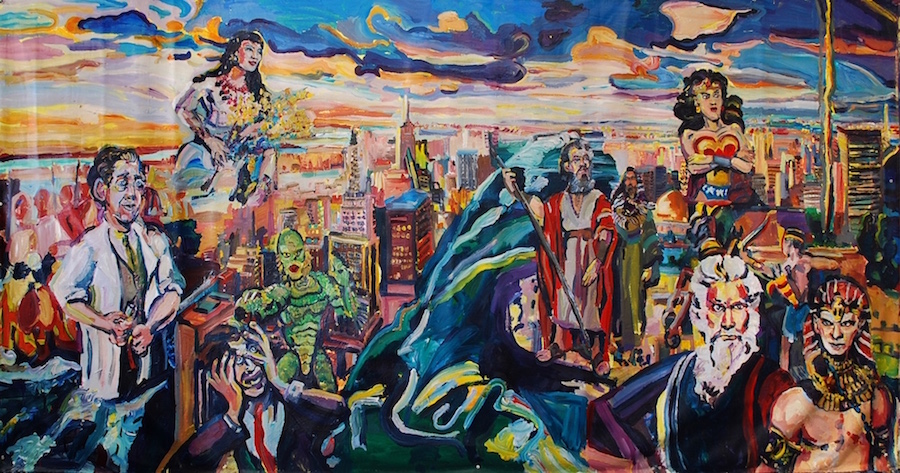Wonder Woman is having a very good year. Her blockbuster movie grossed over 400 million dollars (Gal Gadot must be very happy). Not only that, Wonder Woman made an appearance in this year’s Jerusalem Biennale in Joel Silverstein’s painting, Ten Commandments – A Question. Silverstein’s painting was part of “Jerusalem Between Heaven and Earth,” a Jewish Art Salon exhibition curated by Ori Soltes.
Silverstein’s Ten Commandments is a large figurative painting painted in bright, hi-key colors happily accepting comic book stylistic elements. Depicting Manhattan’s city scape, the painting includes ten figures close to the picture plane, each one taking its own place across the canvas. Wonder Woman is prominently placed on the right side of the painting along with Moses as made famous by Charlton Heston’s tanned face. Toward the left of the image is another famous movie character, the eponymous figure, the “Creature from the Black Lagoon.”

Silverstein’s painting invites us to think about the 10 Commandments and puzzle over the meaning of the picture. Is the artist providing interpretation of the biblical text through his selection of contemporary iconography, for indeed these figures have clear cultural references and meaning, or is he less specific and welcomes us to ask questions? Asking questions is central to Jewish thought and education. I, myself, am quite happy to be left to my own questions, but I also welcome being surprised by another underlying meaning.
Silverstein’s bright comic book-like style is, in many ways, shared by another artist who was recently on view at the Contemporary Jewish Museum in San Francisco. Archie Rand’s monumental work The 613 includes a panel for each mitzvah, good deed, as itemized by Moses Maimonidies.

Rand’s style is bright and highly influenced by pulp fiction and film noir. Each image corresponds to one of the commandments. Like Silverstein, Rand leaves it to us to figure it out. But as the artist has said of himself, he’s a “wise guy,” willing to tease, give us a hard time, or let us in on an “in joke.” So don’t get too series or you’ll miss the gag.
After all, these artists poke a stick in the eye of the mainstream art circles. Don’t let them fool you, too.
Ben Schachter received a bachelor’s degree from Wesleyan University in studio  art and art history, and received an MFA in studio art and an MS in art history and criticism from Pratt Institute. He is currently professor of visual art and chair of the Fine Arts department at Saint Vincent College. He exhibits regularly and gives public lectures.
art and art history, and received an MFA in studio art and an MS in art history and criticism from Pratt Institute. He is currently professor of visual art and chair of the Fine Arts department at Saint Vincent College. He exhibits regularly and gives public lectures.
In the Fall of 2017 his first book “Image, Action and Idea in Contemporary Jewish Art” will be published.


2 responses to ““Wise Guy Artists” by Ben Schachter”
Ten Commandments and a Question, 2016 Acrylic on canvas, 60” 96”. This panoramic work was created especially for the Jerusalem Biennial, 2017. In it characters from history, myth and pop culture freely mingle. On the left side of the painting is a figure derived from the German expressionist painter, Otto Dix, a doctor depicted as an addled drug addict, representing avaricious or degraded behavior. Several characters are present from Cecil B. DeMille’s The Ten Commandments, a Hollywood epic who influence is great on me still. Anne Baxter as Nefertiri is superimposed, as is Wonder Woman, representing the Shekinah next to a pillar of fire leading the Hebrews. In the recent movie, the superheroine was portrayed by Israeli actress Gal Gadot. The narrow plume of flame and smoke stands for God’ presence in the wilderness, but suspiciously looks like an office building conflagration, reminiscent of 9/11 and the anxiety while watching the first videos of the violence. Charlton Heston as Moses is present in the center, with his brother Aaron as played by John Carradine. Moses is also present as an older, more” Biblical” patriarch on the right, complete with whitened spiritualized locks, next to Yul Brynner as the stylish Ramses. The center of the painting is held by a figure in cringing in terror from the oncoming Red Sea and a monster, cribbed from a Depression Era The Shadow pulp magazine and The Creature from the Black Lagoon,1954. The far-left side, as well as the over-all composition were both derived from The Dura Europos Mural, Moses and Aaron leading Israel Out of Egypt, 230 AD. Dura may be the purest form of an indigenous ancient Jewish pictorial art. New York City flanks the center, while Jerusalem, including the Dome of the Rock is on the right side. Then large painting is not stretched but hung with grommets, like a banner. It is a mostly upbeat and accessible manifestation of Jewish experience I wish to render, complete with disparate patches of old and new, high and low, spiritual and mundane; an eminently American Jewish character. The title implies a sense of irony as the Children of Israel accept the Law. “We really appreciate this God, but where have you been?”
Thank you Ben! Your inclusion of my work was really exciting. Although, rather than thinking of myself as a “wise guy”, i prefer trying to read my work without irony and try to see religious meanings within a contemporary sensibility. For me this is a realm where the religious, the historical, fine and popular Art are smashed together. There are narrative and even theological meanings in my works. But I ask the viewer to look for them first.